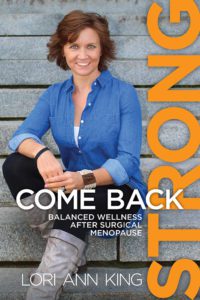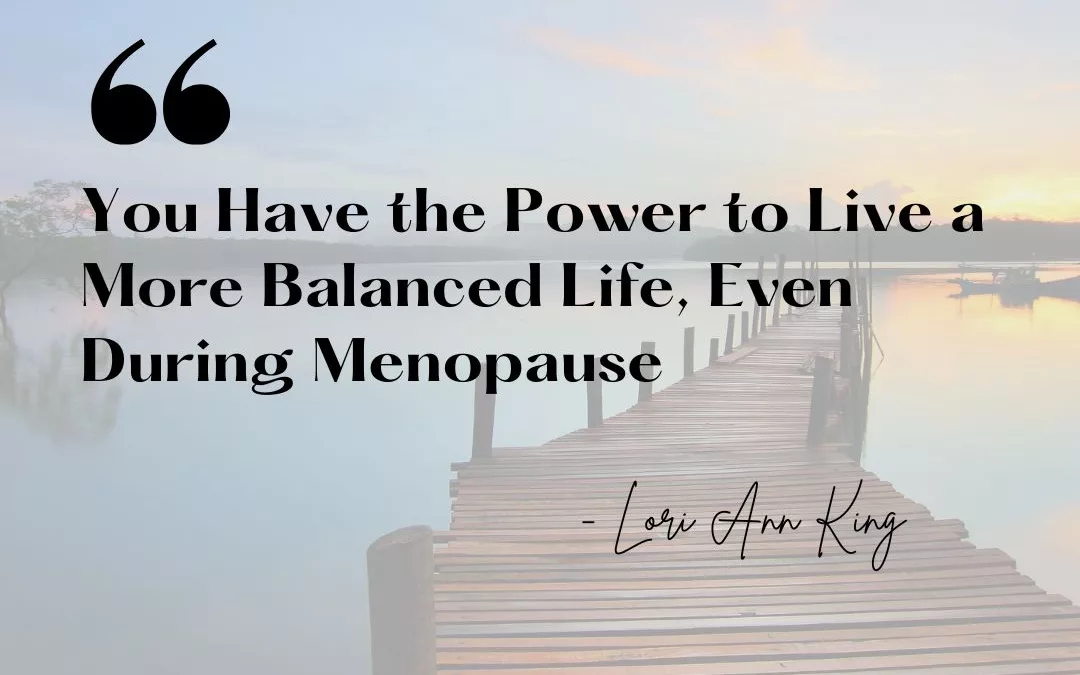However long you’ve been struggling, you can decide today to take action and go to work toward balance during menopause.
“You don’t need to be helped any longer,”
Glinda tells Dorothy. “You’ve always had the power.”
So, you’re moving along through life, relatively comfortably. Sure, not everything is perfect, but everything is familiar. Life is good. You are content.
Hot Flashes, Night Sweats, Insomnia, Oh My!
Then, the hot flashes and night sweats begin. You gain weight. You can’t sleep. You experience brain fog. You are on an emotional rollercoaster that makes PMS look like a kiddy ride at the carnival. You lose your temper or cry at the drop of a hat.
Then, you realize that you’ve lost all interest in your job, your mate, sex, the kids, and pretty much everything in life.
You reach out to Dr. Google and there is talk about HRT but with that comes the scare of more harm. You join an online forum or Facebook group and all you see are complaints without solutions. You ask your doctor for help with your weight and he tells you it is simply part of aging.
Suffering in Silence
Suddenly, you find yourself suffering through menopause in silence.
You feel alone, confused, afraid, overwhelmed, and frustrated. Your quality of life seems to have dropped overnight.
Many women get stuck here for years or even decades. Struggling to find their balance. Wondering if they will ever feel good in their body again.
I know. I’ve been there.
Desperate to feel better, I exhausted ALL the external resources of traditional and nontraditional routes to wellness along with lifestyle changes. I believed I needed something outside myself – a pill, a diagnosis, therapy, advice, or a sign, message, or miracle from God – to feel better.
Wake Up Call
It took menopause – in my case the sudden surgical kind – for me to wake up and embrace the power that I had in my own life to feel goo d in my body, to experience peace and calmness, to find passion and purpose, and to focus on the positive. I came to realize it was within my power to manage my menopause symptoms and improve my quality of life.
d in my body, to experience peace and calmness, to find passion and purpose, and to focus on the positive. I came to realize it was within my power to manage my menopause symptoms and improve my quality of life.
However long you’ve been struggling with the effects of menopause, you can decide today to take action and go to work toward more balance during menopause. It’s time you recognize that you have the power to feel good in your body, mind, spirit, and LIFE! You just may be missing a few tools. That’s why I wrote my book, Come Back Strong, Balanced Wellness After Surgical Menopause, and created my course, Balanced Wellness During Menopause, to help you find your way to the yellow brick road of empowerment.
Menopause Transitions
I speak with women in their forties or younger who complain about fatigue and suspect they might be fighting a cold. Others describe experiencing migraines or bitchiness at certain times of the month. Some have instances of vaginal dryness. What these women have in common is that they don’t always put together that their symptoms are hormonal. They are in a state of premenopause or perimenopause.
What’s the difference between these phases of life and what is the “normal” transition to menopause?
Premenopause arrives first. We may not even notice any changes in our bodies, minds, or moods, but our estrogen and progesterone levels are beginning to drop.
Perimenopause is next. Estrogen levels continue to drop and symptoms begin to arrive for the “party.” Our period becomes irregular. Night sweats and hot flashes begin.
Menopause officially arrives when the ovaries stop releasing eggs.
Medically speaking, we have reached postmenopause when we have been without a menstrual period for twelve consecutive months. We remain postmenopausal until the end of life, even if symptoms continue for months or even years.
My menstrual period ended at age thirty-eight, five years prior to the removal of my uterus. Due to heavy bleeding, I had an endometrial ablation, a procedure where the uterine lining is thinned causing the monthly menstrual period to stop completely, or at least for a while. By definition, I was postmenopausal since I hadn’t had a period in over a year. However, since I still had my ovaries at that time, I felt the normal fluctuations of my hormone cycle.
The Suddenness of Surgical Menopause
My awareness of menopause was limited to understanding that it involves hot flashes and older women. When I heard the words surgical menopause, I thought of hot flashes that start at an earlier age than normal. This was a very simplified version of what goes on with surgical menopause. These images were the only version of what might happen to me that I was aware of with my limited knowledge and perspective prior to my hysterectomy and oophorectomy.
Keep in mind that a hysterectomy itself does not include the removal of ovaries, and therefore will not send a woman into surgical menopause. An oophorectomy is the surgical removal of the ovaries and causes sudden surgical menopause.
The main difference between surgical menopause and natural menopause is the timeframe and intensity of the symptoms related to the transition. During natural menopause, symptoms appear gradually and are sometimes so subtle that we barely notice the changes; and when we do, we can tackle one or two symptoms at a time as they pop up.
Symptoms of Menopause
Menopausal symptoms vary from woman to woman. Sometimes we can look at our family medical history for clues on how we might experience the menopause transition but often it is unique to the individual woman. Nutrition, exercise/movement, stress levels, and previous use of synthetic hormones (birth control pills) may play a role in the symptoms we experience in menopause.
The more common symptoms include
- weight gain or struggle to maintain a healthy weight
- sleep issues and sleep disturbances
- vaginal dryness and
- pain during intercourse
- hot flashes/hot flushes
- changes in sex drive/libido
Hormone Replacement Therapy
My primary care physician (PCP) is also my gynecologist and hormone specialist. Internists, family practitioners, and endocrinologists may also be in your toolbox to help balance your hormones. My PCP is patient and open to listening to my concerns while assisting me to feel my best. I see her every three months, and we fine-tune my hormone levels based on my blood work as well as my symptoms and observations. I’m fortunate to benefit from hormone replacement therapy (HRT).
HRT commonly includes estrogen, progesterone, testosterone, or some combination of the three. It is used to replace or support the body’s natural hormone levels. It is not just for surgical menopause, nor is it exclusive to women. My friend Natalie improved her libido in her thirties by taking testosterone, while my friend Tony began estrogen therapy after his diagnosis and treatment of prostate cancer. HRT can help through many of the menopause transitions and hormone imbalances.
Bioidentical Hormone Therapy vs. Synthetic Hormone Therapy
Synthetic hormones have been around for years in the form of Premarin, Provera, and even low-dose birth control pills. Synthetic means humanmade from chemical sources. I was surprised to learn that Premarin is produced from the urine of pregnant horses, or mares. Who knew? The goal is to create hormones that are similar, although not necessarily identical, to what your body naturally makes to alleviate symptoms. Many doctors prescribe synthetic hormones and many insurance companies cover the cost.
I was introduced to hormone, sexuality, and nutrition expert Camille Lawson, R.N., M.Ed., through a mutual friend. In a blog post entitled “Hormones: The Key to Vibrant Health and Sexuality for Women” she writes: “All bioidentical hormones originate from either soy or diosgenin (wild yam) plant sterols that are put through steps in a lab to become a hormone that is identical to the hormones manufactured by the body. Compounding pharmacies are key to the correct formulation of your hormones after a thorough hormone panel is done.”
Bioidentical hormones are humanmade and plant-based, however, they have the identical chemical structure as the hormones made by our ovaries. Bioidentical hormones are prescribed by a doctor and filled through a compounding pharmacy. The cost is most likely not covered by insurance. That said, my friend Tania had an allergic reaction to synthetic HRT. With that diagnosis, she was able to switch to BHRT and receive financial assistance from her health insurance company.
Bioidentical HRT was my choice for a more holistic approach. I also knew that I wanted a combination of some form of estrogen and progesterone for balance. I liked the idea that the hormone receptors in my body would recognize the yam extracts as familiar. BHRT ended up having a positive effect on my quality of life. Although at first, it didn’t feel like it. I had to take responsibility for things in my life that required my attention. Counseling, mindset, discovering my purpose and passion, and allowing myself to do more of what I loved all played a significant part in my healing and recovery.
Even within wellness circles, there is a lot of controversy over the use of both synthetic and bioidentical hormones. Taking hormone replacements must feel right for you, your belief system, and your knowledge of health and safety. Talk with your healthcare provider(s) and find the treatment plan that feels right for you.
The bottom line is if you require HRT or BHRT or Ambien or Lexapro, or something else to eliminate night sweats, insomnia, anxiety, or depression, talk to your doctors. Explore your options and make an educated decision for this point in time. Then, go to work on lifestyle changes that help to alleviate your symptoms naturally and rebalance your health so that, under the guidance of your medical team, you eventually may not require pharmaceuticals.
 Other Treatment Options
Other Treatment Options
In my book Come Back Strong, I outline many other treatment options for menopausal women including alternative therapies like acupuncture, herbalism, counseling, massage therapy, and even chiropractic. I also discuss the lifestyle changes that can improve your experiences of menopause, including managing your expectations, changing your perspective, reducing stress, improving nutrition, and creating better sleep habits and routines.
Where ever you are in your menopause transition, seek help from a menopause specialist or other health specialists. I also recommend starting the conversation with other women in menopause. This is still somewhat of a taboo subject but there is power in numbers and our shared experiences.
Additional Resources:
From my blog:
- Your Menopause Perspective: Sign of Aging or Second Spring?
- Choosing Faith Over Fear During Menopause
- Sleep, Menopause and Learning to Say No
With love, gratitude, and kindness,
Lori


